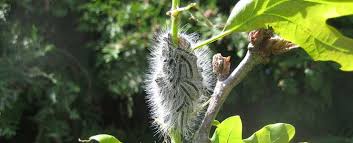The Toxic Caterpillars Are Back
Beware the Oak processionary moth
|

About this time each year the warnings go out in Ealing and other leafy areas to keep children and animals away from hairy caterpillars and their nests in oak trees to avoid itching skin rashes and other health problems.
Oak processionary moth (OPM) caterpillars could be nesting in some oak trees across the borough. They have tiny hairs which contain a protein that can cause itchy skin rashes and, less frequently, eye and throat irritations and breathing difficulties in people and animals.
The greatest risk period is May to July, although nests should not be approached at any time because detached hairs remain within them.
Ealing Council works with the Forestry Commission when required to tackle the nests and moth population in its parks and open spaces with carefully controlled tree treatment and nest removal. Householders who find evidence of the pest in their own oak trees should report it to the Forestry Commission.
The caterpillars build distinctive white, silken nests and trails on the trunks and branches of oak trees, and these can sometimes be as big as a tennis ball.
They become discoloured and harder to see after a time. The nest may appear interesting to children and pets so please take care and report any sightings to the Forestry Commission.
The Forestry Commission advises that the oak processionary caterpillars only build their nests on the trunks and branches of oak trees.
They are never found among the leaves of an oak tree or on structures such as buildings, gates and fences, so caterpillars or nests in these situations need not be reported. They are only rarely found in other trees, and usually only if they run out of oak leaves to eat.
Anyone displaying symptoms including skin or eye irritations following possible OPM contact should visit a pharmacist, or call NHS111 for more-serious reactions. Contact a vet if an animal is affected.
More health advice is also available from the “Insects that bite or sting” area of the NHS Choices website, www.nhs.uk/livewell
For further information on Oak Processionary Moths, please visit the Forestry Commission website www.forestry.gov.uk/opm where there are pictures to help identify caterpillars and their nests.
April 30th 2018